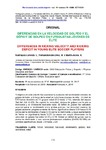Diferencias de edad en el rendimiento de golpeo de balón en fútbol

View/
Use this link to cite
http://hdl.handle.net/2183/24788
Except where otherwise noted, this item's license is described as Atribución-NoComercial-SinDerivadas 3.0 España
Collections
- Investigación (CCDEF) [297]
Metadata
Show full item recordTitle
Diferencias de edad en el rendimiento de golpeo de balón en fútbolAlternative Title(s)
Age-related differences in kicking performance in soccerDate
2019Referenced by
Scopus
Abstract
[Resumo]: El objetivo de este estudio fue examinar la evolución del rendimiento máximo de golpeo de balón a lo largo de la edad en futbolistas jóvenes de élite. Un total de 175 fueron divididos en 11 grupos edad (U-9 hasta U-19), además del equipo filial del club (U-23). Se registró la velocidad máxima de golpeo con la pierna dominante y no dominante mediante radar. El déficit de golpeo fue calculado para comparar el rendimiento entre ambas piernas. La velocidad máxima de golpeo aumenta progresivamente de forma significativa desde U-9 hasta U-16 con la pierna dominante y hasta U-18 con la no dominante, y sigue aumentando de forma no significativa hasta U-23. La etapa con mayor incremento de la velocidad de golpeo fue entre U-13 y U-16. Existe un déficit de golpeo con la pierna no dominante y sus valores permanecen estables (9.43%-18.18%) sin cambios significativos desde U-9 hasta U-23. [Abstract]: The purpose of this current study was to examine the age-related differences in kicking performance with both legs in 175 youth soccer players. Players from the development programme of a professional club were grouped according to their respective under-age team (U-9 to U-18), in addition to the club’s second team (U-23). Maximal kicking velocity with the preferred and non-preferred leg
was recorded using a Doppler radar gun. Kicking deficit was calculated to compare side-to-side performance. Maximal kicking velocity improved progressively from the U-9 to U-16 age groups for the preferred leg and from U16 to U-18 for the non-preferred leg, and continued to improve moderately but non-statistically significant until U-23. The stage of greatest kicking velocity development was between 13 and 16 years of age. There is a kicking deficit with the non-preferred leg and its values remain steady (9.43%-18.18%) without significant changes in players from U-9 to U-23 categories.
Keywords
Fútbol
Velocidad
Habilidad
Rendimiento
Golpeo
Test
Lateralidad
Edad
Football
Kicking
Performance
Ability
Testing
Non-preferred leg
Velocidad
Habilidad
Rendimiento
Golpeo
Test
Lateralidad
Edad
Football
Kicking
Performance
Ability
Testing
Non-preferred leg
Editor version
Rights
Atribución-NoComercial-SinDerivadas 3.0 España
ISSN
1577-0354






